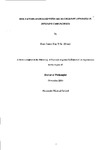RISK FACTORS ASSOCIATED WITH THE MUCOCILIARY APPARATUS IN INTENSIVE CARE PATIENTS
| dc.contributor.author | Kay, Ross James | |
| dc.contributor.other | Peninsula Medical School | en_US |
| dc.date.accessioned | 2013-11-14T09:59:10Z | |
| dc.date.available | 2013-11-14T09:59:10Z | |
| dc.date.issued | 2003 | |
| dc.identifier | NOT AVAILABLE | en_US |
| dc.identifier.uri | http://hdl.handle.net/10026.1/2692 | |
| dc.description.abstract |
Initially, there were two principal aims of this investigation. A laboratory based project studying the effect of elevated fraction of inspired oxygen on the ciliary coverage of rat trachea in culture and a clinically based investigation of the ciliary coverage and frequency of ciliary ultrastructural abnormalities in the bronchus of intensive care unit patients. The mucociliary apparatus is the main airway defence mechanism protecting the lungs from respiratory infections. It is vital in intubated patients, as they lack the back up clearance mechanism normally provided by the cough reflex. Ciliary coverage and ultrastructural integrity are two key components of effective mucus clearance. These initial studies led to the development of a repeatable whole organ culture method incorporating an air interface and a computer assisted method of precisely measuring ciliary coverage. Using these novel protocols the laboratory-based study demonstrated that elevated fraction of inspired oxygen caused ciliary denudation of rat trachea in vivo, the extent of which was proportional to the concentration of oxygen. The control group for the intensive care unit study showed that patient age was not associated with a change in the frequency of ciliary abnormalities in individuals below the age of 60 and illustrated the importance of analysing sufficient ciliary transverse sections under transmission electron microscopy. The intensive care study provided, for the first time, an insight into the mucociliary integrity of long-term intensive care patients. It confirmed that a reduction in ciliary coverage is associated with the duration of ventilatory support and the presence of a bacterial infection. There was no increase in the number of ciliary ultrastructural abnormalities in the ICU patients compared to healthy control subjects. The novel methods developed during this research should provide a reliable approach for assessing potential risk factors in future research, whilst the results of both the laboratory and clinical studies have significantly contributed to our knowledge of the function of the mucociliary apparatus in the critically ill. | en_US |
| dc.language.iso | en | en_US |
| dc.publisher | University of Plymouth | en_US |
| dc.title | RISK FACTORS ASSOCIATED WITH THE MUCOCILIARY APPARATUS IN INTENSIVE CARE PATIENTS | en_US |
| dc.type | Thesis | |
| plymouth.version | Full version | en_US |
| dc.identifier.doi | http://dx.doi.org/10.24382/4265 | |
| dc.identifier.doi | http://dx.doi.org/10.24382/4265 |
Files in this item
This item appears in the following Collection(s)
-
01 Research Theses Main Collection
Research Theses Main


